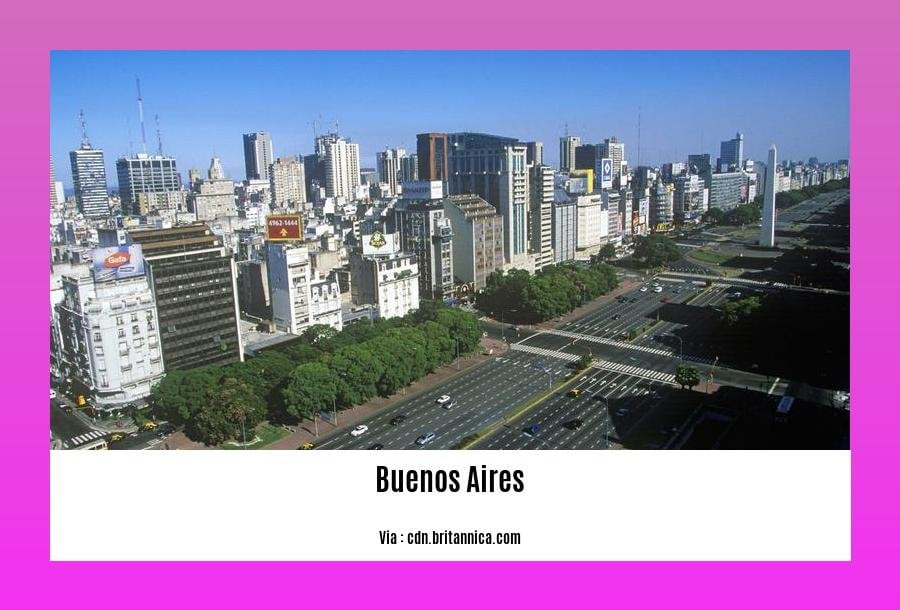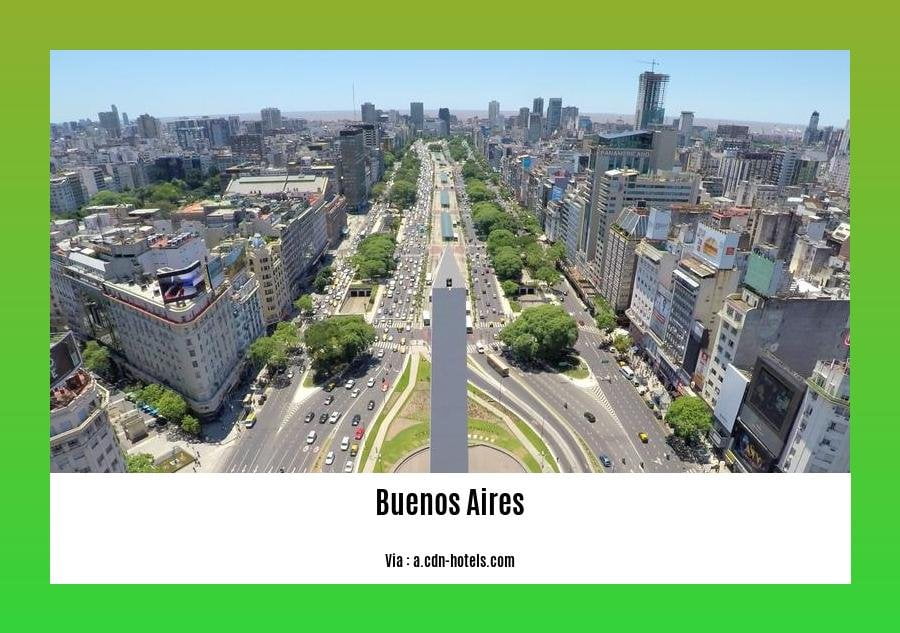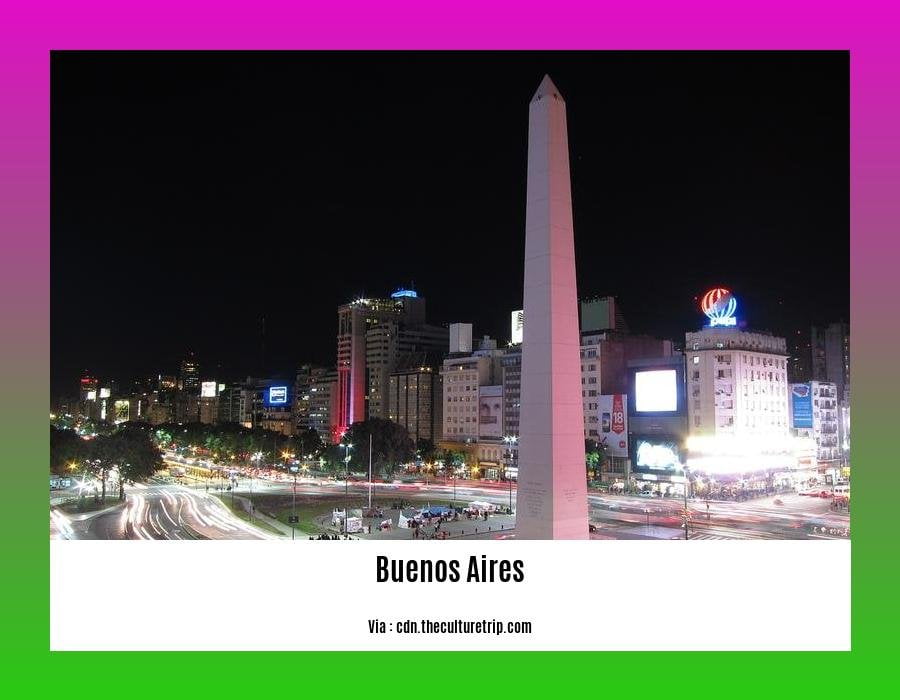Buenos Aires, the vibrant capital of Argentina, is not just another city; it’s a magical land of enchanting experiences. From its UNESCO-listed Tango, born right here, to the widest avenue in the world, Avenida 9 de Julio, this city is full of surprises waiting to astonish you. Dive into this article, dear reader, and discover 10 fun facts about Buenos Aires that will leave you enthralled.
Key Takeaways:
- Buenos Aires, Argentina’s capital, means “Fair Winds” in Spanish.
- Known as the “Paris of South America,” Buenos Aires is Argentina’s largest city.
- The city features famous landmarks such as the Obelisco and the Recoleta Cemetery.
- Buenos Aires is the birthplace of Tango and has the world’s most bookstores per capita.
- Avenida 9 de Julio is the widest street in the world.
- Buenos Aires has Latin America’s oldest metro system.
- The city was the first in Latin America to recognize LGBT rights.
Fun Facts About Buenos Aires

Paris of South America: Buenos Aires is adorned with European-style architecture that evokes the charm of Paris. Its wide boulevards, ornate mansions, and vibrant nightlife have earned it the affectionate title of “Paris of South America.”
Tango’s Birthplace: This soulful dance originated in the streets of Buenos Aires and has become an integral part of the city’s identity. Its sensual movements and passionate rhythms continue to captivate dancers and spectators alike.
Book Lovers’ Paradise: Buenos Aires is a haven for bookworms, boasting the highest number of bookstores per capita in the world. From grand bookstores to hidden gems, literature enthusiasts can indulge in their passion and unearth literary treasures.
The Widest Street in the World: Avenida 9 de Julio, a grand boulevard in Buenos Aires, holds the record for being the widest street in the world. Its 14 lanes allow for a smooth flow of traffic and create a striking urban landscape.
A Metro Pioneer: Buenos Aires is home to Latin America’s oldest metro system, dating back to 1913. Its colorful stations, adorned with intricate tilework and stained glass windows, offer a glimpse into the city’s rich history.
LGBT Rights Champion: Buenos Aires stands as a pioneer in Latin America for its progressive stance on LGBT rights. The city was the first in the region to legalize same-sex marriage and continues to lead the way in promoting equality and inclusivity.
Palermo: The Palermo neighborhood is a diverse and vibrant part of Buenos Aires. It’s known for its parks, museums, and nightlife.
The Obelisco: The Obelisco is a 67-meter-tall monument located in the Plaza de la República. It was built in 1936 to commemorate the 400th anniversary of the founding of Buenos Aires.
The Teatro Colón: The Teatro Colón is one of the world’s leading opera houses. It was built in 1908 and is known for its beautiful architecture and acoustics.
The Recoleta Cemetery: The Recoleta Cemetery is one of the most famous cemeteries in the world. It’s the resting place of many famous Argentines, including Evita Perón and Juan Perón.
You won’t believe these interesting facts about the stunning city of Buenos Aires. Dive in and explore the captivating history, hidden gems, and unique traditions that make this city so beloved.
Prepare to be amazed by the fun facts about the enigmatic Florida Everglades. Discover the secrets of this unique ecosystem, from its incredible wildlife to its fascinating history, and immerse yourself in the beauty and wonder of this natural treasure.
The Teatro Colón is considered one of the best opera houses in the world.

Key Takeaways:
Teatro Colón is among the world’s top ten opera houses and reputed for its exceptional acoustics, ranked among the five best concert venues globally.
Its rich history and architectural elegance are at par with renowned opera houses like La Scala, Paris Opera, Vienna State Opera, Covent Garden, and the Metropolitan Opera.
The current Teatro Colón, constructed over 20 years, opened in 1908, replacing the original theater from 1857.
Did you know: Teatro Colón means “Christopher Columbus Theater” in Spanish, paying homage to the renowned explorer.
Fun Fact: The iconic red-and-gold auditorium can accommodate over 2,400 spectators.
Wow Factor: The exquisite ceiling painting by renowned Argentine artist Raúl Soldi adds to the theater’s grandeur.
Architectural Marvel: The horseshoe-shaped auditorium and ornate balconies exude an old-world charm that transports visitors back in time.
Acoustics Excellence: Teatro Colón’s acoustics are so highly regarded that it is often compared to the legendary opera houses of Italy.
Sources:
– Teatro Colón
– Teatro Colón – Teatro Colón
Tango originated in Buenos Aires.
Buenos Aires, the vibrant capital of Argentina, holds the distinction of being the birthplace of Tango, a dance that has captivated hearts worldwide. This passionate and sensual dance form, characterized by its intricate footwork and close embraces, has woven itself into the very fabric of Buenos Aires’ cultural identity.
Key Takeaways:
Tango’s birthplace: Buenos Aires, Argentina, is widely recognized as the birthplace of Tango.
Evolution of Tango: Tango’s roots can be traced back to a blend of Cuban habanera, Argentine milonga, and Uruguayan candombe, influenced by African and European musical traditions.
Historical context: Initially associated with working-class neighborhoods, Tango gained acceptance in higher society due to the influence of French culture.
Milongas: Buenos Aires is home to numerous milongas, venues where people gather to dance Tango and practice their skills.
Global impact: Tango has gained immense popularity worldwide, inspiring dance enthusiasts across continents.
The Alluring Rhythms of Tango
The music of Tango is as captivating as the dance itself. Its unique blend of syncopated rhythms, passionate melodies, and soulful lyrics creates an atmosphere of intimacy and passion.
The Dance of Passion and Connection
At the heart of Tango lies the connection between two partners. Through intricate footwork, embraces, and improvised movements, Tango dancers express a range of emotions from love and passion to longing and melancholy.
A Cultural Legacy that Endures
Tango has played a significant role in shaping the cultural identity of Buenos Aires. It has inspired countless works of art, music, and literature, becoming an integral part of the city’s artistic heritage.
A Global Phenomenon
Tango has transcended its origins in Buenos Aires, captivating audiences across the globe. Tango schools and dance events have sprung up in cities worldwide, fostering a vibrant international community of Tango enthusiasts.
Preserving the Legacy of Tango
Efforts are underway to preserve and promote the cultural heritage of Tango. In 2009, UNESCO declared Tango an Intangible Cultural Heritage of Humanity, recognizing its unique contribution to world culture.
Citations
[1] 5 cool facts about Buenos Aires
[2] Tango in Buenos Aires: The Top 10 Milongas
FAQ
Q1: What is the significance of the Teatro Colón in Buenos Aires?
A1: The Teatro Colón is renowned as one of the world’s finest opera houses, classified among the five best concert venues globally. Its rich history and exceptional acoustics have earned it a reputation comparable to renowned opera houses like La Scala of Milan and the Paris Opera.
Q2: Why is Buenos Aires known as the birthplace of Tango?
A2: Tango, a passionate and sensual dance, originated in Buenos Aires, embodying the city’s essence. Milongas, venues for practicing and dancing Tango, are popular throughout the city, catering to both beginners and experienced dancers.
Q3: What is the history behind Tango’s Entstehung?
A3: Tango evolved from a fusion of Cuban habanera, Argentine milonga, and Uruguayan candombe, influenced by African and European musical traditions. Initially associated with working-class neighborhoods in Buenos Aires, it gained acceptance in higher society under the influence of French culture.
Q4: What is the significance of Avenida 9 de Julio in Buenos Aires?
A4: Avenida 9 de Julio holds the distinction of being the widest avenue in the world. This iconic landmark is a testament to Buenos Aires’ grandeur and urban planning ingenuity.
Q5: How is Tango celebrated in Buenos Aires?
A5: Buenos Aires celebrates Tango through numerous milongas, catering to dancers of all levels. These venues provide opportunities to practice, socialize, and experience the vibrant Tango culture that permeates the city.
- Senior at What Age: Benefits & Eligibility Guide - March 29, 2025
- Unlocking Senior Benefits: How Old is a Senior? Your Complete Guide - March 29, 2025
- Master Russian Politeness:A Guide to Saying Please - March 29, 2025
















